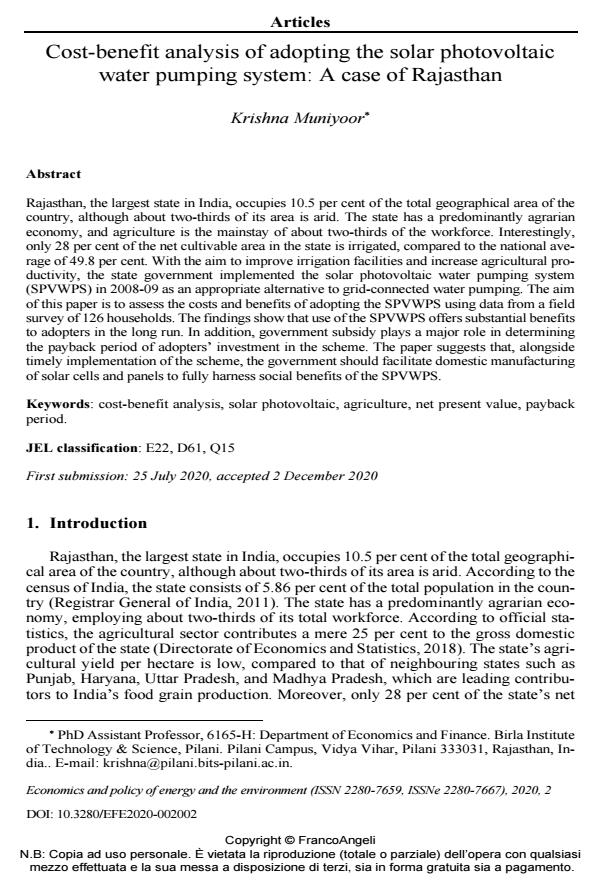Cost-benefit analysis of adopting the solar photovoltaic water pumping system: A case of Rajasthan
Journal title ECONOMICS AND POLICY OF ENERGY AND THE ENVIRONMENT
Author/s Krishna Muniyoor
Publishing Year 2021 Issue 2020/2
Language English Pages 15 P. 35-49 File size 194 KB
DOI 10.3280/EFE2020-002002
DOI is like a bar code for intellectual property: to have more infomation
click here
Below, you can see the article first page
If you want to buy this article in PDF format, you can do it, following the instructions to buy download credits

FrancoAngeli is member of Publishers International Linking Association, Inc (PILA), a not-for-profit association which run the CrossRef service enabling links to and from online scholarly content.
Rajasthan, the largest state in India, occupies 10.5 per cent of the total geographical area of the country, although about two-thirds of its area is arid. The state has a predominantly agrarian economy, and agriculture is the mainstay of about two-thirds of the workforce. Interestingly, only 28 per cent of the net cultivable area in the state is irrigated, compared to the national average of 49.8 per cent. With the aim to improve irrigation facilities and increase agricultural productivity, the state government implemented the solar photovoltaic water pumping system (SPVWPS) in 2008-09 as an appropriate alternative to grid-connected water pumping. The aim of this paper is to assess the costs and benefits of adopting the SPVWPS using data from a field survey of 126 households. The findings show that use of the SPVWPS offers substantial benefits to adopters in the long run. In addition, government subsidy plays a major role in determining the payback period of adopters’ investment in the scheme. The paper suggests that, alongside timely implementation of the scheme, the government should facilitate domestic manufacturing of solar cells and panels to fully harness social benefits of the SPVWPS.
Keywords: Cost-benefit analysis, solar photovoltaic, agriculture, net present value, payback period.
Jel codes: E22, D61, Q15
- Change everything so that (almost) nothing changes? Investigating the territorial distribution of solar energy subsidies in rural India Bérénice Girard, Siddharth Sareen, in Environmental Sociology /2024 pp.385
DOI: 10.1080/23251042.2024.2372890
Krishna Muniyoor, Cost-benefit analysis of adopting the solar photovoltaic water pumping system: A case of Rajasthan in "ECONOMICS AND POLICY OF ENERGY AND THE ENVIRONMENT" 2/2020, pp 35-49, DOI: 10.3280/EFE2020-002002